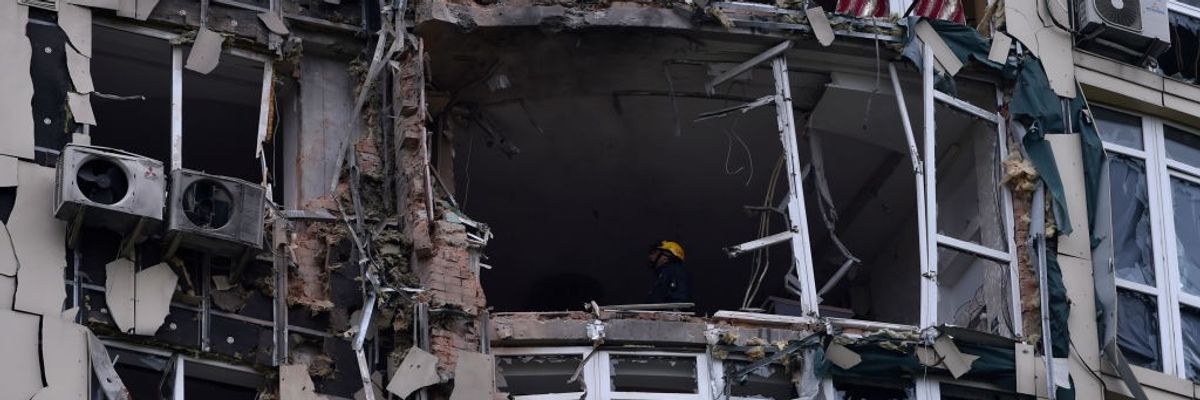
Multistory residential building damaged by shrapnel from a downed kamikaze drone of the Russian army. On the night of May 8, the Russian army attacked the Kyiv region with Iranian-made shock drones "Shahed." The Ukrainian military destroyed 35 out of 35 Russian drones fired at Kyiv. In the city, due to falling debris, houses, road surfaces, and cars were damaged. Five people were injured.
Ground the Killer Drones and End the War Too
In reality, their use only prolongs war and piles up dead bodies.
As the Russian military intensifies its drone attacks on Kyiv and Ukraine’s troops increase usage of homemade drones to hit Russian targets, the region and the world acutely need a proposal calling on both sides to negotiate an end to the war. A first step could be for both sides to agree to stop using weaponized drones.
Current commentary discusses advantages—for one side or the other—of reliance on weaponized drones. But, the history of drone warfare in the Ukraine and in earlier wars, reveals two crucial points.
First, the notion that using killer drones will somehow provide the winning edge in combat is magical thinking. In reality, their use only prolongs war and piles up dead bodies. This has been true, in fact, wherever weaponized drones have been used, since the first modern-day drone attack was launched, unsuccessfully, by the United States on the first day of its Illegal invasion of Afghanistan, nearly 22 years ago.
The notion that using killer drones will somehow provide the winning edge in combat is magical thinking.
Second, the use of weaponized drones spreads war geographically and politically into areas in which generals, independent military leaders, and politicians would not dare to send ground forces. This, of course leads to extremely dangerous, illegal and irresponsible behavior, such as the failed bombing of the Kremlin on May 3, 2023.
As one reads the news of drone attacks, it is possible to think: “Well, today only X number of people died, I can accept the war grinding on”, unless one or more of those dead are people you love.
But the stakes of using drones to kill are extremely high, not only in terms of the consequences of attacking a target of huge political symbolic value, like the Kremlin.
On May 8, Russia announced that it was evacuating nearly 1,700 people, including 660 children, from the area surrounding the Zaporizhzhia nuclear power station, Europe’s largest nuclear plant, because the situation there is, according to the United Nations, “increasingly unpredictable and potentially dangerous.”
On April 5, Reuters reported that a Russian military officer said that a Ukrainian drone had crashed near the plant.
God willing, we have reached a moment in which Ukrainian and Russian leaders, and their wealthy supporters, will realize that weaponized drones are simply a manifestation of their fantastical thinking about achieving “victory” through technology.
The war will stop at some point, all sides will declare victory over a land sodden with the blood and tears of the politically powerless who were not drones, however much they were treated as such.
An Urgent Message From Our Co-Founder
Dear Common Dreams reader, The U.S. is on a fast track to authoritarianism like nothing I've ever seen. Meanwhile, corporate news outlets are utterly capitulating to Trump, twisting their coverage to avoid drawing his ire while lining up to stuff cash in his pockets. That's why I believe that Common Dreams is doing the best and most consequential reporting that we've ever done. Our small but mighty team is a progressive reporting powerhouse, covering the news every day that the corporate media never will. Our mission has always been simple: To inform. To inspire. And to ignite change for the common good. Now here's the key piece that I want all our readers to understand: None of this would be possible without your financial support. That's not just some fundraising cliche. It's the absolute and literal truth. We don't accept corporate advertising and never will. We don't have a paywall because we don't think people should be blocked from critical news based on their ability to pay. Everything we do is funded by the donations of readers like you. Will you donate now to help power the nonprofit, independent reporting of Common Dreams? Thank you for being a vital member of our community. Together, we can keep independent journalism alive when it’s needed most. - Craig Brown, Co-founder |
As the Russian military intensifies its drone attacks on Kyiv and Ukraine’s troops increase usage of homemade drones to hit Russian targets, the region and the world acutely need a proposal calling on both sides to negotiate an end to the war. A first step could be for both sides to agree to stop using weaponized drones.
Current commentary discusses advantages—for one side or the other—of reliance on weaponized drones. But, the history of drone warfare in the Ukraine and in earlier wars, reveals two crucial points.
First, the notion that using killer drones will somehow provide the winning edge in combat is magical thinking. In reality, their use only prolongs war and piles up dead bodies. This has been true, in fact, wherever weaponized drones have been used, since the first modern-day drone attack was launched, unsuccessfully, by the United States on the first day of its Illegal invasion of Afghanistan, nearly 22 years ago.
The notion that using killer drones will somehow provide the winning edge in combat is magical thinking.
Second, the use of weaponized drones spreads war geographically and politically into areas in which generals, independent military leaders, and politicians would not dare to send ground forces. This, of course leads to extremely dangerous, illegal and irresponsible behavior, such as the failed bombing of the Kremlin on May 3, 2023.
As one reads the news of drone attacks, it is possible to think: “Well, today only X number of people died, I can accept the war grinding on”, unless one or more of those dead are people you love.
But the stakes of using drones to kill are extremely high, not only in terms of the consequences of attacking a target of huge political symbolic value, like the Kremlin.
On May 8, Russia announced that it was evacuating nearly 1,700 people, including 660 children, from the area surrounding the Zaporizhzhia nuclear power station, Europe’s largest nuclear plant, because the situation there is, according to the United Nations, “increasingly unpredictable and potentially dangerous.”
On April 5, Reuters reported that a Russian military officer said that a Ukrainian drone had crashed near the plant.
God willing, we have reached a moment in which Ukrainian and Russian leaders, and their wealthy supporters, will realize that weaponized drones are simply a manifestation of their fantastical thinking about achieving “victory” through technology.
The war will stop at some point, all sides will declare victory over a land sodden with the blood and tears of the politically powerless who were not drones, however much they were treated as such.
As the Russian military intensifies its drone attacks on Kyiv and Ukraine’s troops increase usage of homemade drones to hit Russian targets, the region and the world acutely need a proposal calling on both sides to negotiate an end to the war. A first step could be for both sides to agree to stop using weaponized drones.
Current commentary discusses advantages—for one side or the other—of reliance on weaponized drones. But, the history of drone warfare in the Ukraine and in earlier wars, reveals two crucial points.
First, the notion that using killer drones will somehow provide the winning edge in combat is magical thinking. In reality, their use only prolongs war and piles up dead bodies. This has been true, in fact, wherever weaponized drones have been used, since the first modern-day drone attack was launched, unsuccessfully, by the United States on the first day of its Illegal invasion of Afghanistan, nearly 22 years ago.
The notion that using killer drones will somehow provide the winning edge in combat is magical thinking.
Second, the use of weaponized drones spreads war geographically and politically into areas in which generals, independent military leaders, and politicians would not dare to send ground forces. This, of course leads to extremely dangerous, illegal and irresponsible behavior, such as the failed bombing of the Kremlin on May 3, 2023.
As one reads the news of drone attacks, it is possible to think: “Well, today only X number of people died, I can accept the war grinding on”, unless one or more of those dead are people you love.
But the stakes of using drones to kill are extremely high, not only in terms of the consequences of attacking a target of huge political symbolic value, like the Kremlin.
On May 8, Russia announced that it was evacuating nearly 1,700 people, including 660 children, from the area surrounding the Zaporizhzhia nuclear power station, Europe’s largest nuclear plant, because the situation there is, according to the United Nations, “increasingly unpredictable and potentially dangerous.”
On April 5, Reuters reported that a Russian military officer said that a Ukrainian drone had crashed near the plant.
God willing, we have reached a moment in which Ukrainian and Russian leaders, and their wealthy supporters, will realize that weaponized drones are simply a manifestation of their fantastical thinking about achieving “victory” through technology.
The war will stop at some point, all sides will declare victory over a land sodden with the blood and tears of the politically powerless who were not drones, however much they were treated as such.

